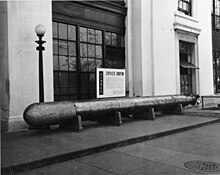| Type 93 torpedo | |
|---|---|
 Type 93 torpedo, recovered from Point Cruz, Guadalcanal, on display outside U.S. Navy headquarters in Washington, D.C., during World War II | |
| Type | Torpedo |
| Place of origin | Empire of Japan |
| Service history | |
| In service | 1933–1945 |
| Used by | Imperial Japanese Navy |
| Wars | Second World War |
| Production history | |
| Designer | Rear Admiral Kaneji Kishimoto and Captain Toshihide Asakuma |
| Designed | 1928–1932 |
| Variants | Type 97 torpedo, Type 95 torpedo |
| Specifications | |
| Mass | 2.7 tonnes (6000 lb) |
| Length | 9 metres (29 ft 6+5⁄16 in) |
| Diameter | 610 mm (2 ft 1⁄64 in) |
| Effective firing range | 22,000 m (24,000 yd) at 89–93 km/h (48–50 kn) |
| Maximum firing range | 40,400 m (44,200 yd) at 63–67 km/h (34–36 kn) |
| Warhead weight | 490 kg (1080 lb) |
| Propellant | Kerosene or similar oxidized with oxygen-enriched air |
| Maximum speed | 96 km/h (52 kn) |
Launch platform | Surface ships |
The Type 93 (酸素魚雷, designated for Imperial Japanese calendar year 2593) was a 610 mm (24 in)-diameter torpedo of the Imperial Japanese Navy (IJN), launched from surface ships. It is commonly referred to as the Long Lance[1] by most modern English-language naval historians, a nickname given to it after the war by Samuel Eliot Morison,[2] the chief historian of the U.S. Navy, who spent much of the war in the Pacific Theater. In Japanese references, the term Sanso gyorai (酸素魚雷, lit. "oxygen torpedo") is also used, in reference to its propulsion system.[3] It was the most advanced naval torpedo in the world at the time.[4][5]
- ^ Boyne 1995, pp. 127, 254.
- ^ Morison 1950, p. 195.
- ^ Sato, Kasumasa (1988). 太平洋海戦 1 進攻篇 (in Japanese). ISBN 4062037416.
- ^ Morison 1984, pp. 23–25.
- ^ Peck, Michael (March 20, 2016). "Japan's Super Torpedo was the Hypersonic Missile of World War II". National Interest. Retrieved March 20, 2016.